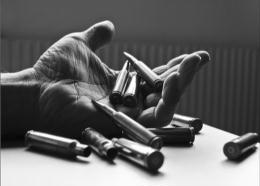

 The Accurate Reloading Forums
The Accurate Reloading Forums  THE ACCURATE RELOADING.COM FORUMS
THE ACCURATE RELOADING.COM FORUMS  Rifles
Rifles  Small Calibers
Small Calibers  .222 accuracy vs .223
.222 accuracy vs .223Go  | New  | Find  | Notify  | Tools  | Reply  |  |
One of Us |
I often hear that the old .222 is more accurate then the .223 ! Is this simply an old urban myth or....? How is the .223 doing in bench rest competition vs. the .222 ? Has the .223 beaten old accuracy records of the .222 ? or will that never happen ? | ||
|
| One of Us |
The 222 was a very accurate round in it's day. When the military was testing a smaller caliber, the 222 was the most accurate but didn't have the velocity potential. The 222 Mag wasn't as accurate. The 223 is nearly identical to 222 Mag; it is close but not the same and not interchangeable. The 223 with newer bullets and different twists is very accurate and very very versatile. I would not be surprized if the 222 is still not a tiny bit more accurate @ 100 yards with 52 gn and less bullets. The PPC cartridges did more to kill the 222 than the 223 in my opinion. The combination of the two definitely put the 222 on the shelf, but you know what they say about opinions! PA Bear Hunter, NRA Benefactor | |||
|
| One of Us |
I have two rifles in 222, two in 223, and two in 222 Magnum. All three chamberings are about equal for accuracy. I think the rifle is very important for any of these, and the best built rifle will dictate which is most accurate, not the chambering itself, as all three are good. I personally like the 222 Magnum better than the 223 as the 222 Mag has a longer neck case. I spent all of this past summer working loads for the above three chamberings, so I have about a bunch of targets that show relative accuracy. Some of the groups, not many, are down in the .1's and .2's, with many in the .3's to .5's. There are so many GREAT bullets in the 50 and 52 grain weight that finding a suitable, accurate load is a breeze. Most of my testing was with TAC powder. We don't have TAC locally, so I bought an 8 pound keg of it mail order and went wild testing it, like a kid with a new toy. Also, there are other powders delivering great accuracy too; like IMR-4198, RL-7, H-335, H-332, and H-4895. Primers tested were Fed 205's, Rem 7 1/2's and CCI BR4's, all delivering outstanding groups for specific loads. Our Benchrest competitions are dominated by the 6mm PPC, with some going to specific chamberings like a small 30 caliber, and some others I dodn't even know about. And, no one shoots any of the above chamberings I discussed. I shot centerfire benchrest in competitions in the 1970's and during the eary years of that decade I used a 222 Rem for my heavy varmint class rifle. Back then, no one used a 223, but many guys did shoot the 222 Magnum bench rifles. Personally, I think the difference in accuracy between the 222 and the 222 Magnum is so slight, I could never win an argument in favor of one or the other. Also, back then, we shot matches at 300 yards, so the 222 mag was probably better than the standard 222. But, for the 100 and 200 yard matches, the best shooter shooting the best rifle won the match, and he could be shooting either chambeing. Don | |||
|
| one of us |
DMB wrote:
That's the perfect summation. Either cartridge has the capability to be surgically accurate, but so many other factors come into play. Bobby Μολὼν λαβέ The most important thing in life is not what we do but how and why we do it. - Nana Mouskouri | |||
|
| One of Us |
I have both and they are both very tight shooting rifles. A person would have to be a much better shot than me to determine that one was better than the other. | |||
|
| one of us |
I think you would have to work with dozens of examples of each cartridge in identical barrels and actions in order to draw any statistically meaningful conclusions. I have worked with far fewer than that, but in my limited experience it seems as if it is a bit easier to get great accuracy from the .222 than from the .223. That is not to say that the .223 can't be outstandingly accurate, only that it might be a bit fussier about which loads do well in it. As has been mentioned, the longer-necked .222 Magnum (which I like a lot) was once considered the best of the trio for bench shooting, but I suspect that this is because the bench shooting fraternity, which is very prone to trends, simply treated the .222 Mag as a more accurate cartridge, thus realizing their expectations. | |||
|
Moderator |
It is a good question, but I doubt you'll ever find an honest answer to it. The bench rest shooters were using the .222 to great sucess until the 22 and 6mm ppc's hit the scene, and then the 223 was forgotten and nobody concerned with competitive accuracy built a .223 for bench rset competition. Then again the .223 has done well in service rifle competition, and many people are using the .223 with fast twist barrels to compete on out to 1000 yds with fair success. __________________________________________________ The AR series of rounds, ridding the world of 7mm rem mags, one gun at a time. | |||
|
| One of Us |
In terms of accuracy the .223 probably never got the testing that the .222 received. The .222 was introduced long before the .223. By the time the .223 came along the 6mm bullet in the .222 Rem Mag case (AKA 6X47) was beginning to take over the benchrest. From there benchrest went on to the PPC cartridges where it is stuck now. | |||
|
| One of Us |
There is so little maximum potential accuracy difference between the SIX cartridges (.221, .222, .223, .222 Mag, .220 Russian, and .22 PPC) that the shooters, the individual rifles, and the loads used MAY always be the more important accuracy factors for any practical use. For what it is worth, if anything at all, in the 1970s Remington reported the records kept for their 40-XBR rifles indicated that in any given bore diameter, the smaller the central fire cartridge case, the smaller the potential groups. They were not building 40XBRs in the .220 Russian or the .22 PPC then, so when it came to .224" bore diameter their records were for the other cartridges. That, of course, was also with the test shots being fired at a distance where trajectory was not a consideration...i.e, 100 yards or less. At that time Remington test fired and kept records of every 40-XBR it built. Whether they still keep such records, and whether they would still say the same thing, I have no idea. | |||
|
| One of Us |
You'd have to be an unusually good shooter to be able to discern any difference. IMO they are equal in all respects except the .223 has an advantage in velocity. | |||
|
| One of Us |
My win mod 70 in .223 is the most accurate rifle I own--with jacketed bullets. But I have tried many combinations and cannot get it to shoot cast bullets. My .222's and 22-250 will shoot the cast bullets but have not matched the accuracy with jacketed bullets that my.223 gets. | |||
|
| One of Us |
The .222 was a competitive benchrest cartridge that acheived great success. The .223 has never been a competitive benchrest cartridge. No, the .223 has never beaten .222 old accuracy records and that will never happen. FWIW, the .222 is an original case design not based on any other. The original .222 designer set out to design the most accurate case based on engineering principles known at that time. | |||
|
Moderator |
It depends on the range. The triple deuce might have the edge at 100 and 200 yds, but at 600 yards the fast twist 223's with the the vld bullets would have the edge due to higher velocity and less wind drift. __________________________________________________ The AR series of rounds, ridding the world of 7mm rem mags, one gun at a time. | |||
|
| One of Us |
Well, never is a long time and we can't predict who may show up with what at any given BR match but that's not been the record. The same guy (Mike Walker of Remington) who developed the .222 also developed the .223, at the military's request. He says, other things being more or less equal, the little guy will consistantly out shoot the bigger guy. And that's been my experience too. | |||
|
| one of us |
As most on this thread seem to know, the .222 case design is NOT inherently more accurate than the .223. It all boils down to the quality of the rig, the quality of the components and the skill of the shooter. There is NOTHING inherently more accurate about the .222 compared to the .223. Yes, it holds more competition records, but that is because the .222 was used almost exclusively and was already established when the .223 came along. No one paid the new kid on the block much attention, and why would they when the triple deuce was working so well? The .223 offered the same basic case design with a bit more capacity -- and more capacity really wasn't needed for what these guys were doing. That's why the .222 is represented so much more than the .223 when one peruses benchrest records. But to say it is superior in accuracy to the .223 when they're basically birds of a feather is simply ludicrous. Bobby Μολὼν λαβέ The most important thing in life is not what we do but how and why we do it. - Nana Mouskouri | |||
|
| One of Us |
Old age is a high price to pay for maturity!!! Some never pay and some pay and never reap the reward. Wisdom comes with age! Sometimes age comes alone.. | |||
|
| One of Us |
Apparently, Remington didn't agree with that pronouncement when it released its information and opinion. Remington wasn't hypothesizing, it was releasing the results of its records from testing many essentially identical rifles which it had made as well as it could specifically for accurate shooting. Design-wise the rifles differed only by the cartridge case volumes for which they were chambered. Granted, the accuracy differences were not great. Even so, Remington felt they were consistent, repeatable, statistically significant, all those nice things with which data can sometimes identify a cause/effect relationship. Admittedly, sometimes data can also mislead. So, let's turn their data on its head. Let's say the data from Remington showed the opposite experiences with their testing...that the .223 was more accurate than the .222...at that point would we be inclined to believe their testing report had any usefulness? Are we to ignore all data from long-term tests, or just Remington's? I mentioned it because it is the only large scale test of which I am aware, which tried to track an answer to the question asked here. In the absence of other similar scale evidence, especially none with contrary results, I'd have to give at least the possibility of crediblity to its conclusions. Do I KNOW if one is more accurate than the other? NO. Do I KNOW if they are of the same accuracy potential? NO. Do I believe Remington lied to shooters when it reported its data? NO. Does it really matter if one is a very small amount more accurate than the other? Probably not. Is either inherently accurate enough for its purposes? Yes. From that point on, as far as I care, everyone can build, board, and row, their own boats. All I wanted to contribute was some not widely known (these days) news about a long-term experiment which provided data quite possibly relevant to the question. | |||
|
One of Us |
Something that has not been mentioned is the difference in throat design. Is there a difference? Regards 303Guy | |||
|
| one of us |
I never owned a BR rifle in 223 so really cann't say how it would do. My 222 was a sleeved action tight neck 1/14 twist barrel. The 223 came out in 60's so it had plenty of time before the 6ppc to be a Br caliber and if one looks at all the wildcat Br rounds off the 222/222mag you have to wonder. Myself I think the 222 was the perfect small factory case for Br the same way the 6ppc is today. I remember when they tried using the 6Br case it was shorten etc still didn't make a BR caliber but it went on to other fame same way as the 223 did. Look at the 6x45/6x47 you couldn't do that with the 222 case. The 222mag case never made it they had to blow it out. I also shoot a 6x47AI was just the 222magAI neck up to 6mm. I was around when they went from 22cal to 6mm in BR was alot going on back then. I'm sure someone back then tried the 223 and it just didn't work out. What you have to remember in Br you also want a rifle that will shoot small groups at 200yds. I don't want to get into a contest over the 223 vs 222 I think the best thing about the 223 gave me a 223AI. VFW | |||
|
| One of Us |
I agree with Tom Holland. Any time a new cartridge comes out, especially a military round with the plentiful and cheap brass, just about anything and everything is done to it that can be done. Look at all the spin offs from the '06 and the .308. I am sure more than one Bench Rifle was built around the .223 --let's face it, if it'd caught on, all those precision smiths would have been re-arming all the .222 shooters | |||
|
| One of Us |
Something else to ponder about... All four cartridges names have "Remington" as part of their SAAMI titles; that is: -221 Remington -222 Remington -223 Remington -222 Remington Magnum As there was no commercial advantage to them in touting any one of those four over another, I find it interesting that Remington noted the smaller the case capacity, the better the average small-group accuracy from the many 40-X rifles they built and tested. | |||
|
| one of us |
I have a Rem 40x Br in 222 and 6x47 the 222 is hwy model and 6x47 light both have (Factory)3" wood BR stocks. In the 80's I order a 223 40x all three 40x's came with 2-5 shot test target plus loads use. Option on the 223 which I ordered was 1/14 twist barrel the same length was the 222. All three rifles test targets gave groups in .2's. It would be nice in a BR match if you could only shoot one/two targets but it is 5 targets and that keeps everything pretty honest IMHO. Rem made some tight neck 40x Br rifles chambered for the 22/6BR best those rifles would do is in the low .2's also I order a plain jane Rem 40x rangemater in 6Rem with 1/12 twist test target were in the high .2's with 80gr HP bullet. VFW | |||
|
| one of us |
I have shot a bunch of 223 rifles that were very accurate... I have only had one 222 rifle, and it was a combo gun... The 222 has a reputation of one of the most accurate factory cartridges ever made... If I had to choose between the 2, for bench rest competion I would pick the 222... For field/hunting use I would pick the 223. DOUBLE RIFLE SHOOTERS SOCIETY | |||
|
| One of Us |
My solution, have one or two of each 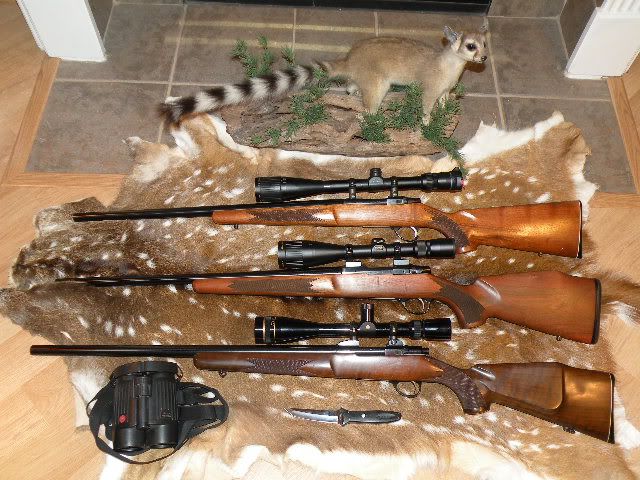 Sako AI, 223 rem. Sako S491, 222rem. Sako L461 "Vixen", 222 rem. Don't tell anyone, but I'm partial to the "deuce" and a few results of a couple range sessions @ 100 yds off the bench. 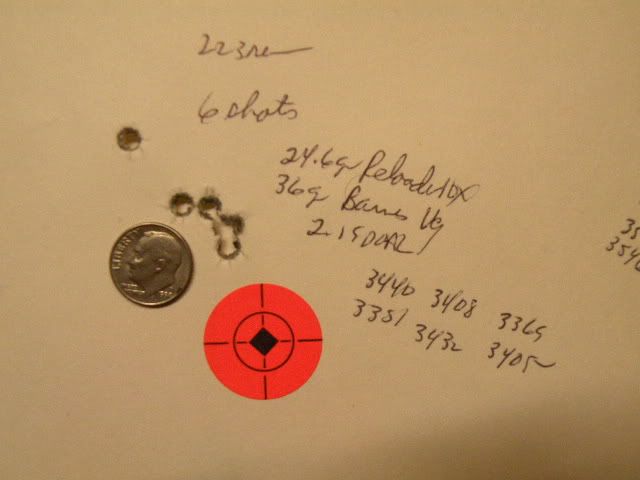 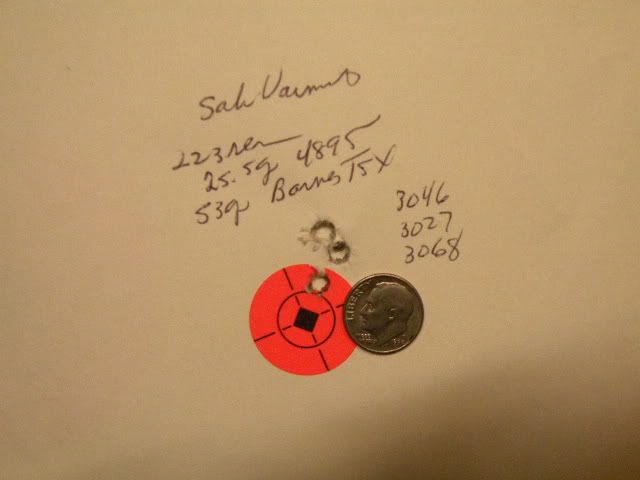  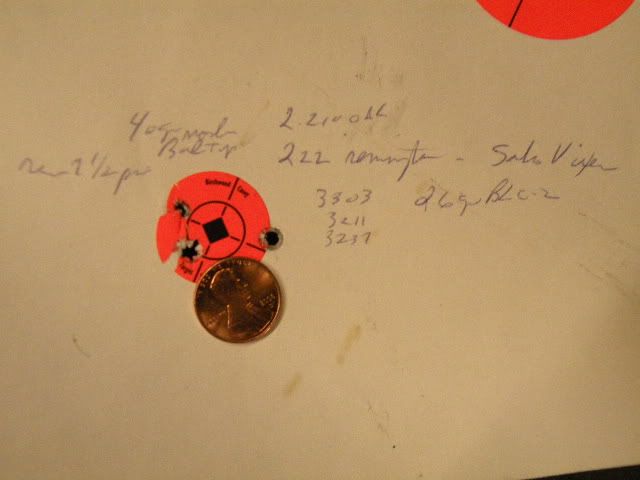 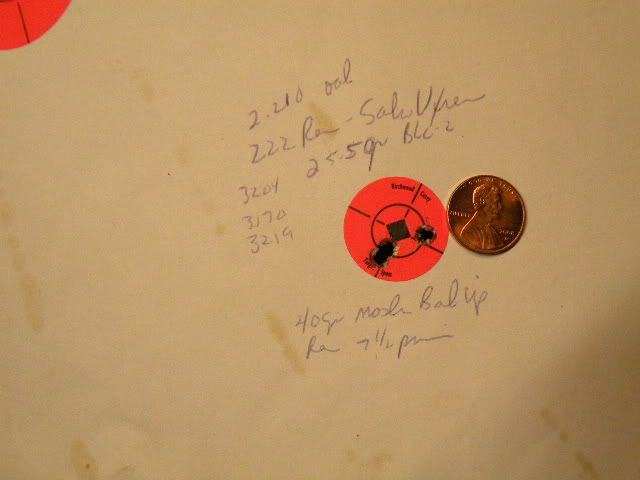 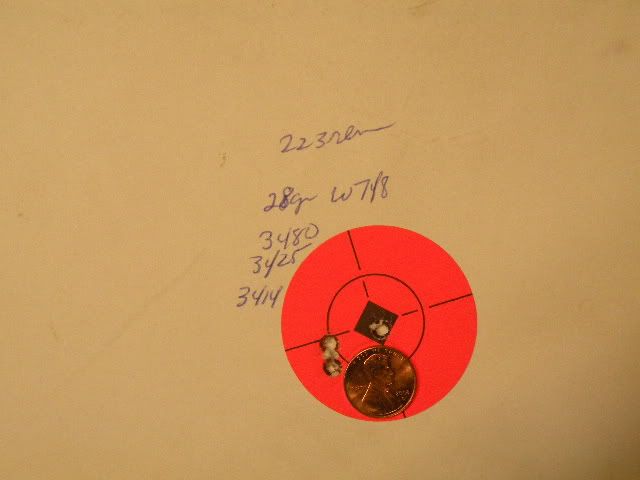 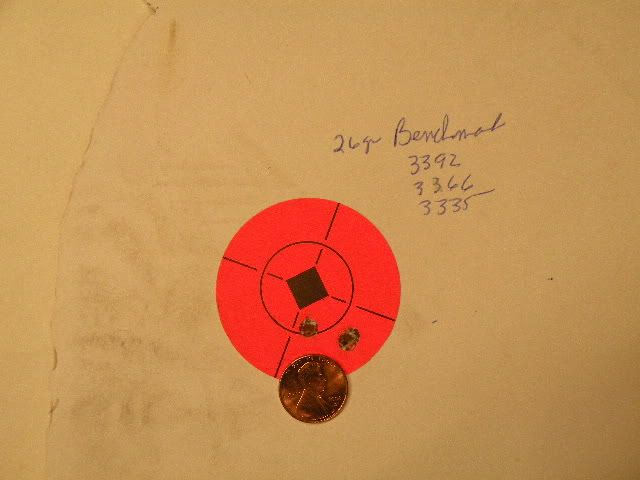 GWB | |||
|
| One of Us |
In the FWIW dept: a .222 round will chamber AND FIRE in a .223 rifle. The results are not pleasant as the primer usually pops whilst the case is extruding to fit the chamber. Don't ask me how I know. You really feel stupid when it happens the second time. | |||
|
| Powered by Social Strata |
| Please Wait. Your request is being processed... |
|
 The Accurate Reloading Forums
The Accurate Reloading Forums  THE ACCURATE RELOADING.COM FORUMS
THE ACCURATE RELOADING.COM FORUMS  Rifles
Rifles  Small Calibers
Small Calibers  .222 accuracy vs .223
.222 accuracy vs .223

Visit our on-line store for AR Memorabilia

